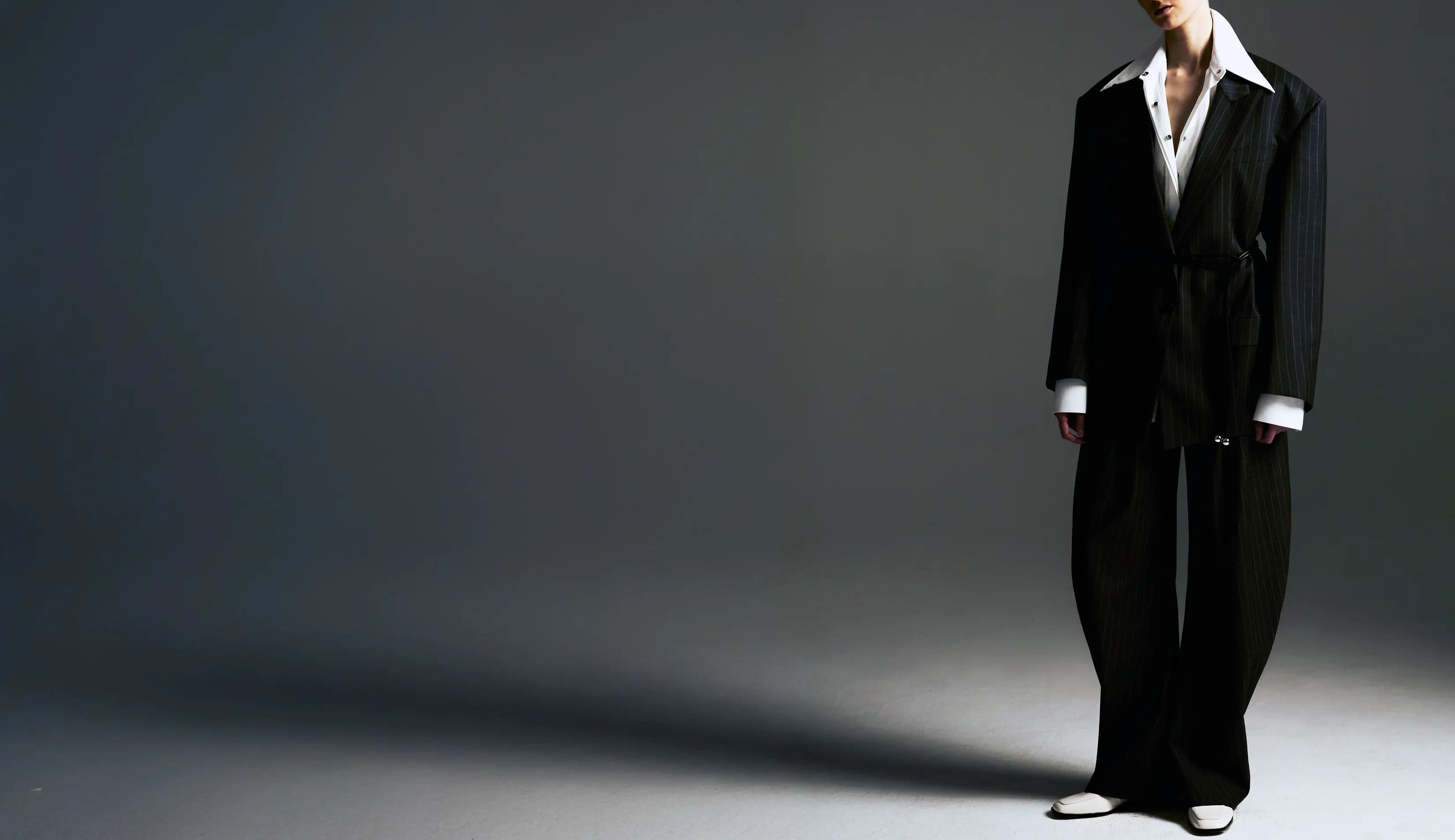Digital Natives Rewrite Retail's Script
The shopping centers rising across China's tier-one cities would confuse the architects who designed Fifth Avenue's flagship stores the way TikTok would perplex Ed Sullivan. These spaces operate on principles that traditional luxury retailers are only beginning to comprehend: experience trumps product, shareability determines success, and authenticity emerges through digital authenticity rather than heritage narratives.
Consider the approach of Shanghai's newest luxury complexes, where augmented reality mirrors allow customers to visualize garments with the precision of bespoke tailoring software. These aren't gimmicks—they're tools that recognize how digital natives process information and make decisions. The floating canvas construction techniques that define superior suiting require expertise to appreciate; these AR systems translate that expertise into accessible, engaging demonstrations that build genuine understanding rather than mere desire.
The integration extends deeper than surface-level technology. Chinese luxury retail spaces now feature dedicated content creation zones—areas specifically designed for customers to photograph and share their purchases with lighting, backgrounds, and angles optimized for various social media platforms. This acknowledgment of shopping as social performance might seem cynical to traditionalists, but it reflects a sophisticated understanding of how luxury functions in a connected world. When a hand-canvassed suit jacket becomes content, its influence multiplies exponentially.
Traditional Western luxury retail resembles a museum—reverent, quiet, exclusive in ways that can feel exclusionary. Chinese luxury retail operates more like a festival—dynamic, participatory, inclusive in ways that expand rather than restrict access to prestige. The difference parallels the contrast between listening to jazz on vinyl in a dimly lit club versus experiencing it live at an outdoor festival where thousands discover Miles Davis for the first time.
Architecture as Emotional Engineering
The curved podium beneath Hangzhou's glass towers represents architectural thinking that would challenge Frank Gehry's assumptions about commercial space. Rather than creating containers for commerce, these structures function as emotional amplifiers, designed to heighten every aspect of the luxury shopping experience through spatial psychology that Western architects are only beginning to understand.
The illuminated storefronts don't simply display merchandise—they create narrative environments where each brand tells its story through light, movement, and spatial relationship. A luxury handbag isn't merely placed on a shelf; it's positioned within a micro-environment that might include living walls, kinetic sculptures, or holographic displays that respond to customer presence. This approach transforms browsing into exploration, shopping into discovery.
The vertical striping on the towers serves functional purposes that extend beyond aesthetic appeal. These patterns create visual rhythm that guides foot traffic flow, establish psychological comfort zones, and provide Instagram-worthy backgrounds that customers instinctively seek for social documentation. Every design element serves multiple masters: brand presentation, customer experience, and social media virality.
Chinese architects designing luxury retail spaces study customer behavior with the intensity of behavioral economists. They track movement patterns, measure dwell times, analyze purchase correlations, and continuously refine spatial relationships to optimize both sales performance and emotional satisfaction. This data-driven approach to luxury space design would mystify the traditionalists who created Saks Fifth Avenue's marble-clad galleries based on European palace aesthetics.
The rooftop gardens crowning these commercial towers represent perhaps the most sophisticated element of this architectural evolution. These spaces serve as transition zones between commercial intensity and urban reality, allowing customers to process their purchases in contemplative environments that feel worlds away from the retail theater below. It's luxury retail's equivalent of the decompression chamber—necessary technology for managing the psychological intensity of immersive shopping experiences.
Sensory Orchestration Replaces Silent Reverence
The soundscape of traditional luxury retail—whispered consultations, muffled footsteps on carpet, the gentle rustle of tissue paper—has given way to carefully orchestrated audio environments that respond to customer presence and purchase behavior. Chinese luxury spaces employ sonic designers who craft acoustic experiences with the precision of recording engineers mixing albums, creating audio atmospheres that enhance rather than distract from the shopping experience.
Scent marketing in these spaces operates with pharmaceutical precision. Different areas of the store feature distinct olfactory signatures that create emotional associations with specific product categories or brand experiences. The fragrance accompanying evening wear differs from the scent associated with casual luxury, creating subconscious connections that influence both immediate purchase decisions and long-term brand loyalty.
Tactile experiences receive equal attention to visual and auditory elements. Surfaces throughout these retail environments invite interaction—from fabric walls that demonstrate textile qualities to digital interfaces that respond to touch with the satisfying precision of high-end audio equipment. Every surface communicates quality through physical interaction, allowing customers to experience craftsmanship principles that might otherwise remain abstract concepts.
Temperature control in these spaces operates zone by zone, creating microclimates that complement the merchandise being displayed. Areas featuring winter coats maintain cooler temperatures that help customers appreciate insulation properties, while sections dedicated to summer collections warm slightly to enhance the appeal of lighter fabrics. This environmental manipulation might seem excessive, but it demonstrates the lengths to which Chinese luxury retail will go to optimize every aspect of the customer experience.
The lighting systems powering these immersive environments would challenge Broadway's best designers. LED arrays capable of millions of color combinations create dynamic displays that shift throughout the day, responding to natural light conditions, seasonal changes, and even individual customer preferences tracked through mobile app integration. A bespoke suit's canvassing details become visible under lighting specifically calibrated to showcase construction quality, while evening wear sparkles under illumination designed to simulate candlelight or chandelier glow.
Cultural Integration Through Digital Innovation
Chinese luxury retail's embrace of cultural elements reflects sophisticated understanding of how tradition translates into contemporary relevance. Rather than displaying antiques or reproducing historical aesthetics, these spaces integrate cultural references through digital storytelling that makes heritage accessible to younger consumers while respecting traditional craftsmanship principles.
Interactive displays might showcase the historical evolution of silk production while demonstrating how contemporary designers incorporate traditional techniques into modern garments. This approach bridges generational gaps, allowing customers to appreciate cultural significance without feeling lectured or excluded by academic presentations of heritage materials.
The integration of traditional Chinese aesthetics through digital media creates opportunities for cultural education that enhance rather than interrupt the shopping experience. Customers might discover the historical significance of certain color combinations, learn about regional textile traditions, or understand ceremonial dress customs through engaging digital presentations that feel more like entertainment than education.
Live demonstrations of traditional craftsmanship techniques—from fabric dyeing to embroidery—occur within these retail spaces, but they're presented with the showmanship of performance art rather than the reverence of museum exhibitions. Master craftspeople work in glass-walled studios where customers can observe their techniques while shopping, creating authentic connections between historical methods and contemporary luxury goods.
The social media integration of these cultural elements creates viral moments that spread appreciation for Chinese craftsmanship traditions far outside the retail environment. When customers share images of traditional silk weaving demonstrations happening within futuristic shopping spaces, they're unknowingly participating in cultural preservation through digital documentation.
Technology Amplifies Rather Than Replaces Human Expertise
The augmented reality systems deployed in Chinese luxury retail spaces operate with precision that would impress NASA engineers. These aren't novelty applications—they're sophisticated tools that address real challenges in luxury shopping, from sizing concerns to style coordination. Customers can visualize how a bespoke suit's shoulder construction will look on their specific body type, or see how different fabric choices affect drape and movement.
Virtual styling sessions connect customers with fashion experts who might be located anywhere in the world, expanding access to specialized knowledge that was previously limited by geography. A customer in Hangzhou can receive styling advice from a consultant in Milan, Paris, or New York, creating global luxury networks that transcend physical location constraints.
The mobile apps supporting these retail experiences function like personal shopping assistants with artificial intelligence capabilities that learn individual preferences, purchase history, and style evolution over time. These systems can predict which pieces a customer might appreciate based on past purchases, current trends, and even seasonal color preferences derived from social media activity analysis.
Payment systems in these environments operate through biometric recognition, facial scanning, or gesture-based approvals that eliminate traditional transaction friction. Customers can complete purchases through eye contact with digital displays or hand gestures that feel more like magic than commerce. This frictionless approach to payment processing aligns with luxury retail's goal of removing barriers between desire and acquisition.
The data analytics powering these technological systems provide insights that would revolutionize traditional luxury retail operations. Real-time tracking of customer movement, product interaction, and purchase behavior creates feedback loops that allow for continuous optimization of product placement, pricing strategies, and inventory management—all while maintaining the discreet service standards that luxury customers expect.
Social Commerce Redefines Luxury Access
The integration of social media influencers into physical retail spaces represents perhaps the most radical departure from traditional luxury retail conventions. These spaces feature dedicated areas for content creation, live streaming, and collaborative shopping experiences that blur the lines between retail, entertainment, and social media in ways that would perplex the Madison Avenue executives who built luxury marketing's traditional playbook.
Pop-up styling sessions featuring prominent fashion influencers create events that draw customers who might never enter traditional luxury stores. These collaborations generate authentic content that showcases products in use while building community around shared aesthetic values. The approach transforms luxury retail from individual consumption into collective celebration, much like how music festivals turned album listening into shared cultural experiences.
Group shopping experiences designed for social media documentation encourage customers to bring friends, creating natural word-of-mouth marketing while enhancing the entertainment value of luxury shopping. These social experiences generate multiple perspectives on products, creating richer content and stronger purchase confidence among participants who might otherwise feel intimidated by traditional luxury retail's solitary nature.
The concept of "social fitting rooms" allows customers to share styling decisions with friends or family members in real-time, regardless of physical location. Multiple people can participate in clothing selection through video connections, making luxury shopping a collaborative rather than solitary experience—democratizing access to opinion and support that traditional luxury retail restricted to sales associates.
Live streaming shopping events hosted within these retail environments reach customers who might be anywhere in the world, expanding the potential market for luxury goods while creating exclusive access to limited merchandise. These events combine entertainment, education, and commerce in ways that traditional trunk shows never achieved, turning product launches into cultural moments that generate engagement far past the point of purchase.
Sustainability Meets Spectacle
The environmental considerations built into these immersive retail environments reflect growing consumer awareness of sustainability issues without sacrificing luxury appeal. Green technologies power the spectacular displays, while waste reduction systems ensure that the theatrical elements don't come at environmental cost—proving that responsible luxury retail can actually enhance rather than compromise the customer experience.
The rooftop gardens serve multiple environmental functions while enhancing the luxury experience. These spaces filter air, reduce urban heat island effects, provide natural cooling for the buildings below, and create peaceful environments where customers can contemplate their purchases. The gardens demonstrate how luxury retail can contribute positively to urban environments rather than simply extracting value from them.
Energy systems powering the complex lighting and digital displays increasingly rely on renewable sources, with solar panels integrated into building design in ways that enhance rather than compromise architectural aesthetics. The transparent commitment to environmental responsibility appeals to younger luxury consumers who expect brands to demonstrate values alignment through concrete action rather than marketing messaging.
Waste reduction programs within these retail environments operate with precision that would impress industrial engineers. Packaging materials are designed for reuse or recycling, fitting room waste is minimized through digital sizing systems, and excess inventory is managed through predictive analytics that reduce overproduction—addressing luxury retail's historically wasteful practices without compromising service quality.
The transportation systems serving these retail complexes incorporate electric vehicle charging stations, bike sharing programs, and public transit connections that reduce the carbon footprint of luxury shopping while maintaining accessibility for customers who value environmental responsibility. This integration proves that sustainable practices can enhance rather than limit luxury retail's appeal to discerning consumers.
Economic Ripple Effects Through Retail Innovation
The economic impact of these immersive luxury retail environments extends far outside their physical boundaries, creating employment opportunities, technological innovation, and cultural export potential that traditional retail models never achieved. The skilled technicians, creative professionals, and cultural specialists required to operate these spaces represent new categories of luxury retail employment that didn't exist when department stores defined the industry.
Local artisans find new markets for their work through integration into these retail experiences, where traditional craftsmanship gains contemporary relevance through digital presentation. This creates economic opportunities for cultural preservation while expanding appreciation for traditional techniques among younger consumers who might otherwise overlook handmade goods in favor of mass-produced alternatives.
The technological innovations developed for these retail applications often find applications in other industries, creating intellectual property value that extends the economic impact of retail investment. Companies developing AR systems for luxury fashion might adapt their technologies for medical applications, architectural visualization, or educational programs—multiplying the return on retail technology investment.
Tourism revenue generated by these destination retail experiences contributes to local economies while establishing cities like Hangzhou and Shanghai as luxury shopping destinations that compete with Paris, Milan, and New York. The architectural significance of these spaces attracts visitors who might not otherwise travel for shopping, creating secondary economic benefits for hotels, restaurants, and cultural attractions.
The global influence of Chinese luxury retail innovation creates export opportunities for the technologies, design concepts, and operational strategies developed within these environments. International luxury brands increasingly look to Chinese retail innovations for inspiration, reversing traditional flows of retail expertise and establishing China as a leader in commercial space design.
Future Implications for Global Luxury Retail
The retail innovations emerging from China's luxury market will inevitably influence global luxury retail strategies, much like the country's manufacturing capabilities transformed global production in previous decades. Western luxury brands that ignore these developments risk obsolescence in the same way that Nokia dismissed smartphone innovation—by underestimating how quickly consumer expectations can shift when superior alternatives become available.
The integration of technology, culture, and commerce demonstrated in Chinese luxury retail represents a template that other markets will adapt to local conditions and consumer preferences. The principles underlying these experiences—immersion, shareability, cultural relevance, and technological enhancement—translate across cultural boundaries even when specific implementations vary according to local aesthetic preferences.
The generational shift in luxury consumption patterns exemplified by Chinese retail innovation will spread rapidly throughout global markets, driven by digital natives who gain purchasing power and refuse to accept retail experiences that feel outdated or disconnected from their daily digital lives. The expectation that luxury retail should be experiential, interactive, and socially connected won't remain limited to Chinese consumers.
The architectural approaches pioneered in Chinese luxury retail will influence commercial real estate development globally, much like how shopping malls transformed suburban retail landscapes in previous decades. Developers increasingly recognize the economic advantages of creating destination shopping experiences rather than simple retail containers, leading to more ambitious projects that integrate gardens, entertainment, and cultural elements into commercial spaces.
The success of Chinese luxury retail innovation will encourage similar experimentation in other emerging markets, creating a diverse ecosystem of retail approaches that challenge Western luxury retail's historical dominance. This diversification benefits global consumers through increased innovation and cultural representation in luxury markets, while creating new opportunities for brands that understand how to adapt to local preferences.
The sophistication of Chinese luxury retail experiences suggests that the future of luxury commerce lies not in preserving traditional approaches but in continuously reinventing the relationship between brands, products, and consumers. The glass towers of Hangzhou, with their rooftop gardens and illuminated storefronts, represent more than architectural achievement—they embody a fundamental reimagining of what luxury retail can become when freed from historical constraints and empowered by technological possibility.
The transformation resembles the difference between watching movies on television and experiencing them in IMAX—not simply an enhancement of existing approaches, but a complete redefinition of what's possible within the medium. The immersive retail experiences emerging from Chinese luxury markets challenge every assumption about how luxury brands should present themselves, engage customers, and build lasting relationships in an increasingly connected world.
The principles seams together like pieces of a master tailor's pattern—each element contributing to a larger design that creates value through integration rather than individual excellence. The future of luxury retail lies not in choosing between tradition and innovation, but in weaving them together with the same precision that defines a hand-canvassed suit jacket, where every stitch serves both structural and aesthetic purposes, creating garments that honor craftsmanship while embracing contemporary possibilities.




